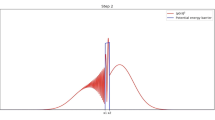Abstract
Several years ago, in quantum mechanics, Davies proposed a method to calculate particle’s traveling time with the phase difference of wave function. The method is convenient for calculating the sojourn time inside a potential step and the tunneling time through a potential hill. We extend Davies’ non-relativistic calculation to relativistic quantum mechanics, with and without particle-antiparticle creation, using Klein–Gordon equation and Dirac Equation, for different forms of energy-momentum relation. The extension is successful only when the particle and antiparticle creation/annihilation effect is negligible.

Similar content being viewed by others
References
Binnig, G., Rohrer, H.: IBM J. Res. Dev. 30, 355 (1986)
Parikh, M.K., Wilczek, F.: Phys. Rev. Lett. 85, 5042 (2000). arXiv:hep-th/9907001
Peres, A.: Am. J. Phys. 48, 552 (1980)
Davies, P.C.W.: Am. J. Phys. 73, 23 (2005). arXiv:quant-ph/0403010
Klein, O.: Z. Phys. 53, 157 (1929)
Dombey, N., Calogeracos, A.: Phys. Rep. 315, 41 (1999)
Calogeracos, A., Dombey, N.: Contemp. Phys. 40, 313 (1999). arXiv:quant-ph/9905076
Alhaidari, A.D.: Phys. Scr. 83, 025001 (2011). arXiv:0907.5588 [quant-ph]
Ni, X., Huang, L., Ying, L., Lai, Y.-C.: Phys. Rev. B 87, 224304 (2013)
Acknowledgement
We are grateful to the referees for valuable comments. This work is supported by the National Natural Science Foundation of China (Grant No. 11105053), and partially by the Open Research Foundation of Shanghai Key Laboratory of Particle Physics and Cosmology (Grant No. 11DZ2230700).
Author information
Authors and Affiliations
Corresponding author
Appendix: Derivation of Expression (39)
Appendix: Derivation of Expression (39)
Using the continuity conditions of the wave function (37) at x=0 and x=a, we can derive
For notational simplicity we have defined M=k/p, N=(E−m)/(E−V−m). Making use of this result and following the same logic in Sect. 3.2, one can prove that the phase change is
Consequently, the tunneling time is found to be
Note that
we can rewrite (A.3) as
Rights and permissions
About this article
Cite this article
Xu, DY., Wang, T. & Xue, X. Quantum Tunneling Time: Relativistic Extensions. Found Phys 43, 1257–1274 (2013). https://doi.org/10.1007/s10701-013-9744-2
Received:
Accepted:
Published:
Issue Date:
DOI: https://doi.org/10.1007/s10701-013-9744-2




